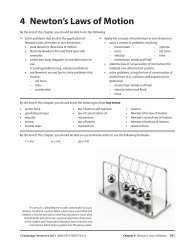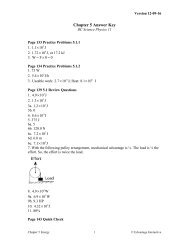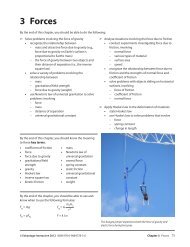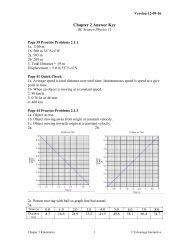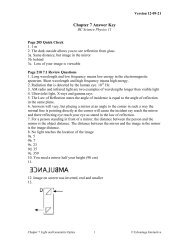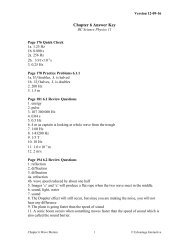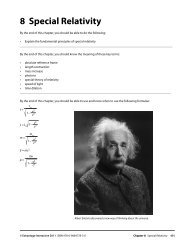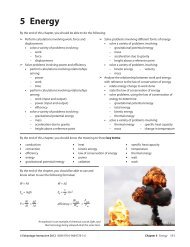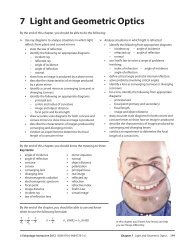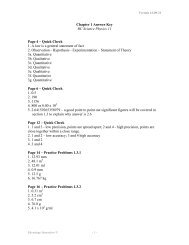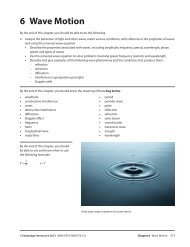2 Kinematics - BC Science Physics 11
2 Kinematics - BC Science Physics 11
2 Kinematics - BC Science Physics 11
You also want an ePaper? Increase the reach of your titles
YUMPU automatically turns print PDFs into web optimized ePapers that Google loves.
2.1 Speed and Velocity<br />
Warm Up<br />
Imagine you are on a hike from a parking lot to a waterfall 2 km away. Is there a way you could describe to<br />
someone that the hike was 4 km long and 0 km long? Explain your answer.<br />
The Study of Motion<br />
Distance and<br />
Displacement<br />
How far did it travel? How long did it take? How fast did it move? Did it speed up or slow<br />
down? These are typical questions one might ask about any object that moves, whether it<br />
is a car, a planet, an electron, or a molecule. All of these questions fall under the heading<br />
of kinematics: the study of the motion of objects, without reference to the cause of<br />
the motion. In kinematics, we learn how to describe the motion of objects in terms of<br />
measurable variables such as time, distance, speed, and acceleration.<br />
When you take a trip a road sign will tell you the distance you have to travel to reach<br />
your destination. This distance is usually measured in kilometres. Other distances you are<br />
familiar with include metres, centimeters, and millimetres. Each of these measurement<br />
units tells you how far two points are apart. Because magnitude, or amount of distance<br />
covered, and not distance is stated, distance is a scalar quantity. The symbol for distance<br />
is d.<br />
In the vector section of Chapter 1, two methods for determining direction were<br />
described. The first method involved the use of positive (+) and negative (–) signs to<br />
indicate direction. Any motion right or up is usually considered positive. Any motion left<br />
or down is usually considered negative. The second method uses compass points. North<br />
and east are usually considered positive, and west and south are negative. Sometimes this<br />
can change depending on the question. For example if all the motion is downward, you<br />
may consider using down as positive so the math calculations do not involve negative<br />
signs.<br />
When a direction is added to a distance, the position of an object or person is<br />
described. For example, if you are 5 km [east] of your home you are describing your<br />
position. Position is the shortest distance between the origin and where the person or<br />
object is located. Position is a vector quantity and includes magnitude and direction. The<br />
symbol for position is d → .<br />
If you change your position by moving another position 5 km [east] of your original<br />
position, then you have a displacement. Displacement is a change in position and is<br />
a straight line between initial and final positions. It includes magnitude and direction.<br />
The symbol for displacement is ∆d → . It is calculated by determining the change from one<br />
position to another. Or put mathematically:<br />
∆d → = d →<br />
f – d→ 0<br />
38 Chapter 2 <strong>Kinematics</strong> © Edvantage Interactive 2012 ISBN 978-0-9864778-3-6



